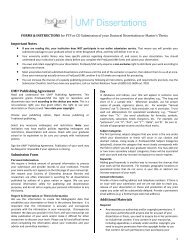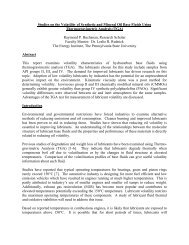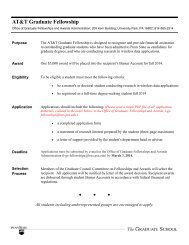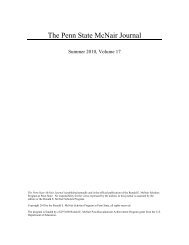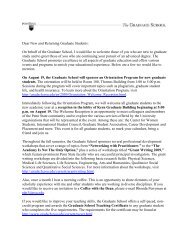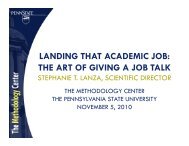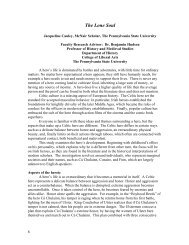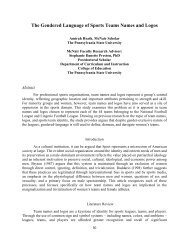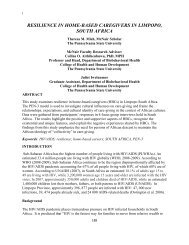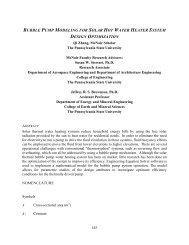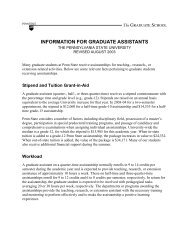1 GRADUATE COUNCIL MEETING 18 January 2012 102 Kern ...
1 GRADUATE COUNCIL MEETING 18 January 2012 102 Kern ...
1 GRADUATE COUNCIL MEETING 18 January 2012 102 Kern ...
You also want an ePaper? Increase the reach of your titles
YUMPU automatically turns print PDFs into web optimized ePapers that Google loves.
SUPPORTING DOCUMENTATION REQUIRED FOR PROGRAMS, OPTIONS, OR MINORS<br />
(Adds, Changes, or Drops)<br />
Page E6<br />
Submit 1 copy of the proposal form and 25 copies of the supporting documentation to the Curriculum Coordinator at the University<br />
Faculty Senate Office, 101 <strong>Kern</strong> Graduate Building. It is important that the proposal include a copy of the program in a format suitable<br />
for inclusion in the Graduate Degree Programs Bulletin. Prepare documentation in the outline format as shown below.<br />
The proposer is reminded that the Subcommittee and Committee reviewing the proposed program may not have knowledge of the field<br />
and is encouraged to provide as much documentation as possible for the reviewers.<br />
A. Program Objectives. An explanation of how the proposal meets the new educational objectives and/or strengthens existing<br />
programs of the college(s) and the University; what students may expect to accomplish through the new program; and, a<br />
statement of how the new offering does not duplicate other degree programs within the department/college/University.<br />
• Background. The AE department instituted an integrated undergraduate/graduate degree program in 1999 that permitted<br />
undergraduate students to pursue both a professional bachelor’s degree (B.A.E., Bachelor of Architectural Engineering) and a<br />
professional master’s degree (M.A.E., Master of Architectural Engineering). This program has been very popular among AE<br />
undergraduates as shown in Table 1. Graduates of this program are easily employed, but do not command significantly higher<br />
salaries than Penn State AE graduates who have only earned a bachelor’s degree. Feedback from employers indicates that<br />
B.A.E./M.A.E. graduates are of top quality, but lack the skills that a research-based master’s degree, such as a Master of Science<br />
(M.S.) degree, would provide. With the availability of the integrated undergraduate-graduate (B.A.E./M.A.E.) degree program, the<br />
Penn State AE students who have pursued the department’s M.S. degree have primarily been a small number of the Schreyer<br />
Honors Scholars in AE who pursue an integrated B.A.E./M.S. program through the Schreyer Honors College.<br />
Table 1. B.A.E. and M.A.E. Graduates 2006-2010<br />
Academic Year Number of B.A.E. Graduates<br />
Number of B.A.E./M.A.E.<br />
Graduates<br />
2006-2007 84 45<br />
2007-2008 117 56<br />
2008-2009 92 42<br />
2009-2010 99 46<br />
The AE program has achieved reasonable success recruiting students into the M.S. program from other four-year schools, but<br />
relatively few from AE undergraduate programs. Since many research projects in AE are relatively short in duration, it is difficult<br />
to fund an M.S. student for two years on a single project. Most M.S. degree candidates are, therefore, funded by more than one<br />
project, with only one serving as the student’s thesis project.<br />
Objectives. An integrated undergraduate-graduate B.A.E./M.S. degree program would benefit both the students and their<br />
employers by adding an integrated research component to the student’s degree programs. The department would also benefit<br />
from the pool of highly qualified M.S. degree candidates whose funding requirements match the length of many of the research<br />
projects. Additionally, the exposure to research would help attract more highly qualified students into the Ph.D. program.<br />
More than half of the Penn State undergraduates who complete the B.A.E./M.A.E. degree do so in five years. This can be<br />
accomplished by a student who has entered Penn State with Advance Placement credits, or by a student who takes a sufficient<br />
number of summer credits. The latter is currently accomplished by a large number of AE students through the 12-credit Summer<br />
in Rome program that is available through the College of Arts and Architecture. In order for students to complete their<br />
B.A.E./M.A.E. degree in five years, most AE students complete five 500-level courses in three semesters while simultaneously<br />
working on their two-semester senior project. The B.A.E./M.S. program will allow students to spread their graduate courses over<br />
one or two additional semesters and enable them to focus on their graduate studies while also offering them a valuable integrated<br />
research experience.<br />
Penn State undergraduate students who enroll in an integrated B.A.E./M.S. program may be funded on research projects for any<br />
additional time required beyond their normal five-year undergraduate program. In addition to the benefits already noted for the<br />
students, the faculty and the department would benefit in a number of ways:<br />
1. Less funding would be needed to produce an M.S. degree through an integrated B.A.E./M.S. program since these<br />
students would generally be funded only for one or two semesters.



